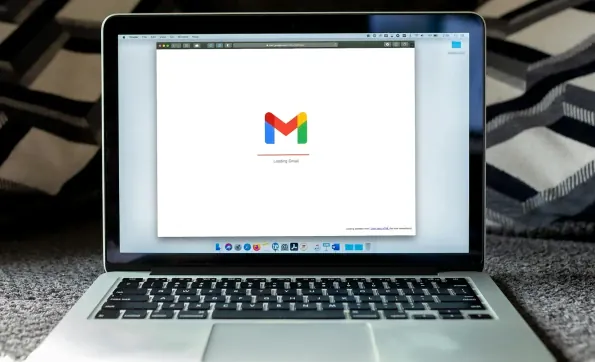Listen to the Article
The widespread adoption of artificial intelligence (AI) technology in daily operations, including personalized recommendations and medical research, makes it predictable that cybercriminals would also exploit this tool. Recently, security researchers warned all 1.8 billion Gmail users about a sophisticated mail service attack. This advanced threat is dangerous because it combines AI-based robocalls and social engineering phishing emails that can trick even the most vigilant users into giving up their account access.
The new scam targets web users through their deep-rooted fear of account lockouts. A two-step cyberattack starts with a robocall automation alerting users about detected suspicious activity in their Google account. But this robocall is no ordinary recording. It represents an AI-generated deepfake voice that perfectly mimics an official Google security team representative in delivering its message. After receiving the phone call, recipients receive a fraudulent email that displays the standard characteristics of an official Google security alert. The message capitalizes on users’ fear of account threats before leading them to imitations of Google’s official login interface. The users then provide access as they type in their login information to the phishing trap.
What is particularly disturbing is that the damage does not stop there. Gmail accounts these days are interconnected with a wide range of other services, from Google Drive and Google Photos to YouTube and third-party apps logged in with Google. Infect one account, and attackers can get their hands on everything, from private messages and personal documents to financial information and sensitive documents. Read this article to learn more about how these cyberattackers operate and the steps you can take to protect yourself and your business.
AI Supercharges an Old Scam
Phishing and robocalls have been going on for a long time, but the current campaign has combined AI-generated voices, caller ID spoofing, and advanced phishing emails to create a successful strategy of deceit.
In an article about the scam, cybersecurity firm Malwarebytes says none of these elements are revolutionary individually, but in combination they create an extremely effective scam. How easily and affordably cybercriminals can perform these attacks is the issue. A McAfee report titled “State of the Scamiverse” states that it only takes 10 minutes and $5 to create a realistic deepfake voice recording. It is thus easier for scammers to conduct efficient campaigns that penetrate millions of users without needing sophisticated technical skills or huge amounts of money. According to the same report, 59% of respondents say they or someone they know has been a victim of an online scam.
The FBI Sounds the Alarm
And it’s not only email services like Gmail or Yahoo under attack. The FBI alerted iPhone and Android users to an increase in telephone scams involving spoofed caller IDs to pose as banks, police departments, and government agencies. For example, residents of Long Island, New York, have been receiving calls from scammers claiming to be the Suffolk County Police Department telling them there are warrants out for their arrest and asking for payments to settle the issue.
The FBI suggests that if you receive a call like this, you should hang up immediately without pressing any buttons or talking to the caller. If you wish to check if the call is legitimate, call the organization directly using a verified phone number from their official website.
Why Gmail Users Are Prime Targets
Gmail’s popularity makes it a highly attractive target for scammers. With over 1.8 billion users, the number of potential victims is staggering. And a Gmail account is very often the key to a person’s entire digital identity. Most people use their Gmail address to sign up for online banking, social media accounts, shopping accounts, etc.
Once one of these hackers breaks into a Gmail account, they can reset the passwords on dozens of other accounts, effectively gaining control of someone’s entire online identity. Such break-ins could result in catastrophic financial losses, reputational harm, and disclosure of very sensitive information.
In some instances, these intrusions lead to identity theft, when perpetrators open credit accounts or make false charges in the victim’s name.
How to Protect Yourself
Although the increasing technicality of the scams is chilling, Gmail users can protect themselves from most of them. Cybersecurity experts have given recommendations to neutralize this new danger.
1. Be Skeptical of Unexpected Communications
If you receive an unexpected call or mail, even when it seems to come from a familiar contact, hesitate a moment before reacting. Hackers depend on creating a perception of urgency in an attempt to trigger instant responses. Don’t fall for that trap!
2. Never Click on Suspicious Links
Phishing emails typically have links to duplicate websites that mirror original websites. Rather than clinking on the link, type the true website address into your browser manually. If you are not sure about the genuineness of an email, log in to your Gmail account through a secure browser and look for any official announcements there.
3. Don’t Share Your Recovery Codes
Never share two-factor authentication or account recovery codes with anyone via phone or email. No legitimate organization will ever request these from you, as they are private security tools used to protect your account.
4. Use a Password Manager
A password manager can make and maintain robust passwords. Password managers can further automatically identify true websites which is an added feature. If the password manager will not autofill your information, it may be an indicator that you are logged into a cloned website.
5. Monitor Your Accounts
Always monitor your account activity and turn on notices for any suspicious sign-in. Catching it early can enable you to act right away and minimize the damage.
The Role of AI in Cybercrime
As more advanced AI tools become accessible, cybercriminals are getting creative with utilizing them for illicit purposes. Deepfakes have already been deployed to impersonate business executives to facilitate corporate fraud, resulting in employees unknowingly transferring millions of dollars into fraudulent accounts. The same technology is now being used against regular users.
The battle between security experts and cyber attackers will likely intensify. AI by itself is neither good or evil—it is simply a tool that may be used for good or for evil. What is certain, though, is that the availability of AI technology has made it even easier for even low-level cyber criminals to send very sophisticated attacks.
Conclusion: Education Is The Best Defense
Technology alone cannot resolve this problem. As quickly as security experts devise new countermeasures, hackers develop new techniques to bypass them. The best long-term safeguard is education. Users who learn the tactics and warning signs of today’s scams are less likely to fall victim.
All Gmail users should understand that new potential dangers are now lurking. They should consider every unwanted phone call, message, or mail suspicious—no matter how genuine it may seem.
Gmail’s massive user base provides hackers with constant targets, and the application of AI in robocalling and phishing has brought the threat to a higher level. However, by being informed and following fundamental cybersecurity rules, users can minimize their risks.





